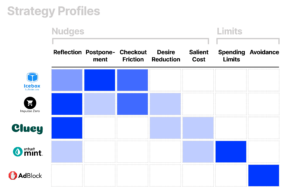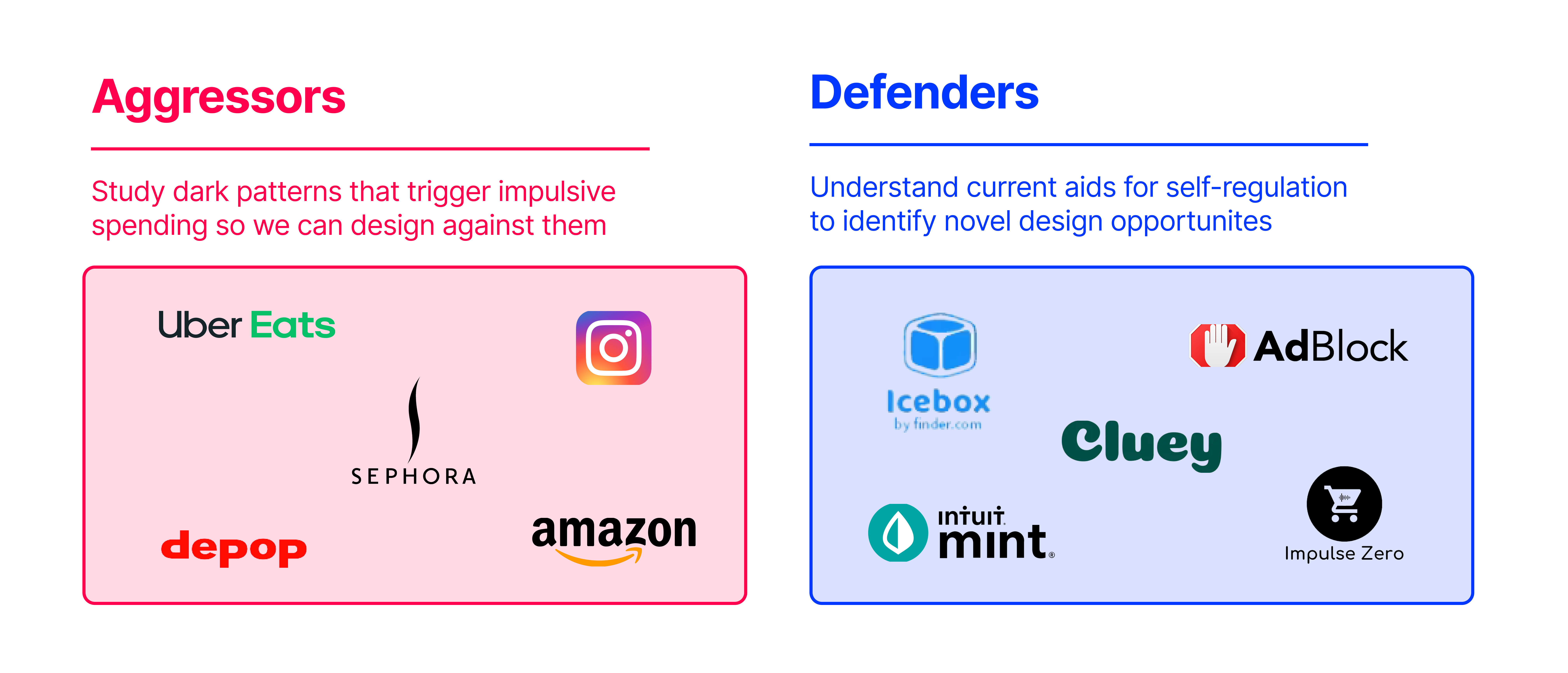E-commerce has grown tremendously. While this growth provides unprecedented levels of access and convenience for online shopping, it also increases the risk of overspending, mindless buying, and impulsive purchases. In fact, about 40% of all online consumer spending is attributable to impulse buying.
| Our goal is to help users who want to change their online shopping habits.
We explored ten existing technologies related to online shopping to deepen our knowledge of the problem and solution space.
Analyzing Both Sides of the Field 😈👼
 Figure 1 – The ten apps we analyzed, grouped into aggressors and defenders
Figure 1 – The ten apps we analyzed, grouped into aggressors and defenders
The tech we analyzed can be roughly grouped into two categories:
- Aggressors – which trigger and promote online spending;
- Defenders – which aid self-regulation and are designed to inhibit overspending
Breaking Down Aggressor Strategies 💣
How do digital retailers get people to spend more? Dark patterns, recommendations, social influence, and more.

Figure 2 – Aggressor selling tactics contrasted with potential underlying motives and impacts
We analyzed the “selling tactics” of five e-commerce technologies (see Figure 2 for synthesis). Their sales strategies can be roughly grouped into two categories:
- Leveraging Psychological Biases: adapted from existing offline strategies
- Social Hijacking: hijacking mental models associated with social media to motivate online shopping
Aggressor Deep-Dives – Features based on general psych biases
DoorDash & UberEats
DoorDash and UberEats are popular food delivery apps providing users with quick and convenient access to takeout. They primarily rely on eliminating friction and conveying urgency through hard-to-miss home screen features to drive orders.
- “Recently ordered” restaurants: a row of restaurant cards that appear on DoorDash’s home screen, reducing re-ordering friction immensely.
- “People also ordered” upsells: before an order is confirmed, UberEats proposes a few “peer”-endorsed restaurant items the shopper can add to their order. This drives impulse purchases through convenience and social proof.
Sephora
Sephora is a retail app that sells makeup, skincare, and beauty products. It nudges users to make impulsive purchases by sending re-engagement triggers and inducing urgency through scarcity messaging.
- Re-engagement push notifications: to loop users back to the commerce app after browsing sessions that concluded without an order or abandoned carts.
- Time-limited promotions: on the home screen drive us to buy things by activating our fear of missing out on a “generous” deal.
- “Only a few items left”: low-stock warnings induce perceived scarcity and urgency, leading shoppers to cease deliberation and just “full send.”
Amazon
Amazon holds perhaps the widest selection of products in cyberspace. It is brimming with tactics that encourage spending – from low friction flows, to personalized recommendations, to default nudges. Fortunately, it also has a few features that encourage more deliberative decision-making.
- Default subscriptions: Amazon unleashes “recurring” product subscriptions as the default instead of one-time purchases to nudge users to spend more.
- “Customers Who Bought This Item Also Bought”: every product page features a recommendation engine with social proof framing designed to increase browsing time and greater subsequent likelihood of purchases.
- Wishlists and “saved for later” bins: the ability to bookmark products shoppers can return to later creates an opportunity for rational deliberation.
Aggressor Deep-Dives – Mimicking social media
Instagram Shop
Instagram Shop integrates “Shop” pages into companies’ existing Instagram profiles, where users can browse curations of a brand’s items and check out in-app. It increases online impulses by introducing a newfound ubiquity of shopping triggers in our lives and decreasing the proximity between social comparison and purchasing material goods.
-
- Social media leads channel: Expands customer acquisition channels to include direct social media conversion.
- Reduced ad-to-purchase friction: by allowing in-app checkout (vs. traditional product advertisements that prompt users to visit external websites).
- High social comparison: Impulsive purchases are also more likely in high-social comparison contexts where material goods are often associated with social capital (that’s Instagram!).
Depop
Depop is a peer-to-peer marketplace for pre-loved clothing. It looks a lot like Instagram, inducing social media-like associations between downtime and online spending. Users can scroll through a personalized feed of items for sale, like and comment on item posts, and host their own Instagram profile-esque storefront.
- Hijacks your downtime: Mimics scrolling behavior to strengthen the psychological link between boredom or downtime and online spending, so that every time you’re not doing anything, you think of online shopping.
- Fits into your social media routine: facilitates an on-the-go, mobile-driven experience that fits into existing social media routines.
Assessing the Defenders Landscape 🗺️
Finding gaps, inspiration, and lessons in the current solution landscape

Figure 3 – Defender strategy profiles: columns encode anti-impulsion strategies, rows represent the associated app’s strategy profile (the darker the square, the more heavily the app uses the strategy).
We synthesized the strategy profiles of each app (see Figure 3) and analyzed their implementation methods. Four significant gaps in the existing solution space emerge:
- Lack of integrated solutions that use in-event nudges AND encourage long-term preference shifts to larger, long-term rewards.
- Many strategies validated by academic research aren’t used, including desire reduction, cost salience, spending limits, and avoidance.
- Current solutions focus on treating the impulse to buy instead of preventing it from occurring in the first place. The only app that prevents users from experiencing shopping temptations in the first place is AdBlock, but the value it provides stops there.
- Lack of mobile-based interventions: all the direct solutions we found only work on desktop, but people shop on mobile too! And social triggers are way more prevalent on mobile.
Defender Deep-Dives – inspiring features and cautionary tales
Icebox – chrome extension
An intuitive purchase-postponer that encourages online shoppers to delay gratification.
Icebox is a chrome extension that hides the “Buy” button, instead asking users to put the product “on ice” for some number of days before buying. It forces postponement so that shoppers can reflect on their purchase motivations. However, research suggests that intermission without specific tasks doesn’t exert a significant effect in reducing impulse purchases. It does redeem itself with an intuitive product metaphor (“put purchases on ice”, “set cool-down period”, “break the ice with essential purchases”, etc.), but with no celebration after successful self-control, it misses out on driving up user’s behavior change motivation.

Impulse Zero – chrome extension
Prompt-giver that defuses impulsive buying thoughts before you can click “Buy.”
Impulse Zero is a chrome extension that requires the shopper to answer reflection prompts like “How many times will you use this in a month?” before they can click the “Buy” button. The reflection nudges online shoppers into System 2 thinking (slow, effortful, and logical mode), preventing impulsive purchases. We also like its very simple task flow (just answer the questions that appear!), noticed that the questions asked don’t prompt reflection on goals and personal values. The extension also doesn’t save user inputs to feed into progress tracking.

Mint – app
A highly accurate tool for spend monitoring and goal tracking.
Mint is a personal finance app that syncs with your bank account and lets you track your spending, create budgets, monitor financial goals, and receive alerts when you’re overspending. It requires a high degree of user initiation is not for the faint-hearted or unmotivated. It’s also not specifically designed to change online shopping behaviors, but when paired with well-timed nudges and reflection-based interventions, the ability to accurately capture spending gives it the power to shift preferences toward long-term gains rather than instant gratification.

AdBlock – chrome extension
An app that quietly eliminates online shopping triggers from your desktop life.
AdBlock is a chrome extension that mutes distracting ads, which may help online shoppers avoid experiencing shopping temptations. However, it isn’t impulsive shopping-specific so it doesn’t contain the same level of useful strategies as other interventions out there. It is also desktop-only whereas user interviews revealed that Instagram and other social apps are where the most common triggers for online shopping.





